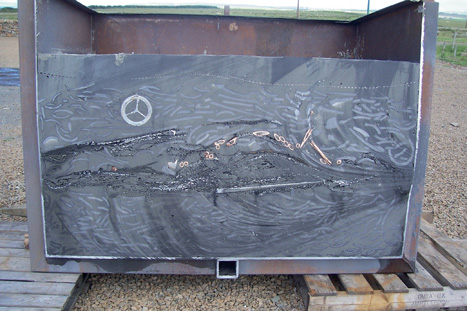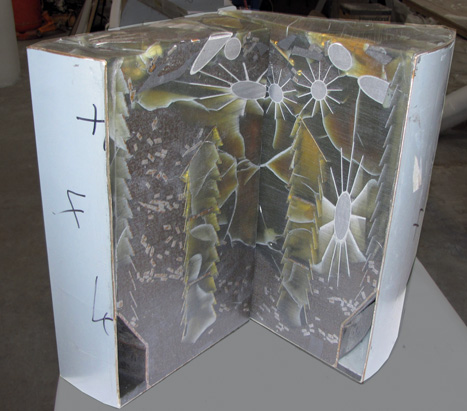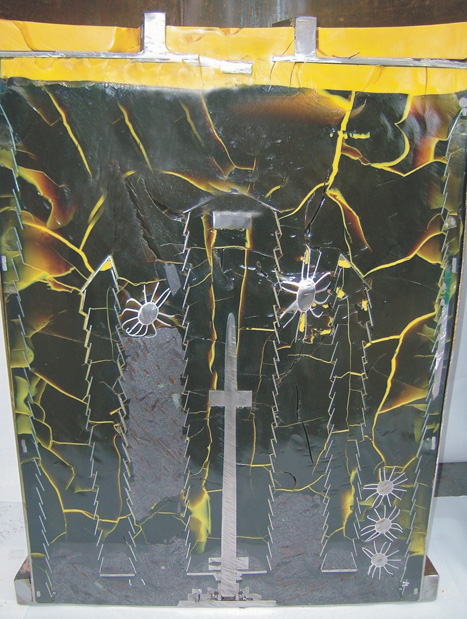The UK has a unique problem with nuclear waste. As a pioneer in the nuclear sector in terms of the development of weaponry and of nuclear power a variety of equipment designs were used in the early days, along with unusual materials and much experimentation.

Even though the development work took place mostly in the 1950s and the 1960s, the legacy remains: a large stockpile of waste often described using the mild-sounding adjective ’exotic’. Very different from that produced by commercial thermal reactors, it presents problems for the decommissioning process. All of these wastes have to be encased in materials that will contain their radioactivity when they are placed within the proposed deep geological repository; and the encapsulation must remain intact until the activity has declined to safe levels. In some cases, this could take thousands of years.
Engineering consultancy Babcock is taking the lead on waste encapsulation, and technical and assurances service group section manager Steven Black told The Engineer that, for many wastes, there is a tested and approved treatment method. Spent fuel, for example, is vitrified before being sealed in a copper canister. Most other wastes are entombed in a cement box filled with a grout, made from Portland cement mixed with powdered fly ash from furnaces or blast furnace slag. This mixture is chemically stable, has established physical properties, is proven to be long lasting and is cheap. It’s also compatible with most types of waste. Most, but not all.
’There are certain types of waste for which cement is just not suitable,’ said Black. Metallic wastes can be troublesome, particularly when the metal is more than moderately chemically reactive, such as aluminium, metallic uranium (as opposed to the uranium oxide used in nuclear fuel) and the cladding for magnox fuel canisters. The metal can start to corrode inside the cement, leading to the cracking of the grouting material and the generation of flammable hydrogen gas, allowing water to penetrate the block of grout. ’It’s particularly problematic when the metal has sharp edges or is in the form of fines or swarf from machining,’ he added.

Other problematic materials include ion exchange resins and some polymers. Cement won’t stick to any surface that repels water, so the materials can be poorly encapsulated.
’The large majority of waste forms can be handled with conventional encapsulation, but a small proportion probably a single-figure percentage can’t,’ said Black. ’But that’s still a large volume and tonnage of waste.’ Known as WRATs (wastes requiring additional treatment) or orphan wastes, these materials are being studied for their suitability to encapsulation in polymer materials.
High-molecular-weight polymers have been proposed before for nuclear waste encapsulation as they have a number of advantages: they are resistant to acids, alkalis and organic solvents; they retain radioactive elements well and resist their leaching out of the polymer matrix; they provide a barrier against moisture; and they don’t allow metals to corrode. In fact, a vinyl ester styrene is in use at a waste-treatment plant in Traesfynydd, Wales, to encapsulate ion exchange resins.
However, styrene polymers use a volatile precursor material that is a fire risk with some applications, and they are also difficult to formulate, said Black; if the waste contains any water, they may not cure effectively.
Problematic materials include ion exchange resins and polymers
To get around this, Babcock is looking at different polymers such as epoxy resins. This could be useful for one of the biggest single waste problems in the UK: the Windscale Piles. These were two reactors developed to make plutonium for Britain’s first nuclear bombs by bombarding canisters of uranium with neutrons from nuclear fission, and were the scene of a huge fire in 1957. Uranium fuel inside Pile 1 overheated and ignited, destroying the reactor. The pile was sealed after the fire was extinguished, but it still contains 15 tonnes of uranium fuel, as well as aluminium cartridges with sharp-edged fins, isotopes of exotic metals such as plutonium, a large amount of graphite (from which the pile was built) and scorched debris. The pile isn’t due to be fully decommissioned until 2037.
’Windscale Pile 1 is a prime example of waste that needs alternative treatment,’ said Black. ’But there is a problem with epoxy: it generates heat when it cures, and the temperatures can get very high 50kg of epoxy will get up to about 200ºC, and that’s not acceptable in a nuclear encapsulation facility.’ One option being investigated is low-temperature-curing epoxy formulations, but another option might be to use a filler along with the waste. ’The polymer is mixed with a powdered material, which is itself chemically inert, such as silica sand, blast-furnace slag and glass microballoons,’ said Black. ’They bulk out the polymer, which means there’s less epoxy to react, and they’re designed to conduct heat, so they knock the overall temperature right back and also prevent shrinkage on curing. We’ve also had good results with powdered graphite as a filler, which is a double win, as we have a large amount of graphite waste to dispose of.’
“Epoxy generates heat when it cures, and temperatures can get up to about 200°C”
STEVEN BLACK, BABCOCK
The other consequence is that it cuts the cost of encapsulation. ’When we buy epoxy at the half-tonne scale, it’s about £20 per kilo, whereas Portland cement is £80 per tonne,’ he added. ’There is a massive cost difference with polymers of any type, but we’ll have to use them where there’s no alternative.’

Another option is siloxane polymers. Rubbery when first made, silicones degrade when exposed to radiation; the side chains gradually break down into non-radioactive, low-molecular-weight molecules that escape as gases, leaving a silicate matrix. ’In effect, it’s a low-temperature vitrification process,’ said Black. ’And they cure at low temperature, so processing them is a lot simpler.’
Babcock has carried out physical tests on siloxanes, because there was a concern that the rubbery form might be too soft. However, this fear proved unfounded; a drum filled with sharp-edged bars and rods encapsulated in siloxane rubber was dropped from 15m and the bars stayed in the same position. ’The flexibility even helped, we think, because if we’d dropped a grouted drum, we’d expect some internal cracking,’ he added.
Much of the research has centred around assessing how the materials will respond to radiation doses, which is complicated by the length of time the wastes must be kept safely encapsulated. ’Over the 10,000 years we need to keep the waste safe, we can expect a radiation dosage of 10 million grays,’ said Black. ’We’ve delivered that dosage over a short period of time and we’ve applied a smaller dose of radiation very slowly and compared that with an accelerated dose, and we get identical characteristics.’
in depth
well-placed rust
’Nuisance’ iron compound has been found to render toxic metal ions harmlessResearchers at Copenhagen University have found that an iron compound previously thought of as a nuisance could protect groundwater against contamination from nuclear wastes held in a repository. Known as ’green rust’, the compound forms naturally when iron is in oxygen-poor water.
Green rust contains a reactive form of iron and has been the subject of research as it causes serious problems if it forms inside reinforced concrete. However, geochemist Bo Christiansen has found it can also render toxic metal ions harmless. ’A while ago, we showed how green rust can convert carcinogenic chromium-6 to non-toxic chromium-3,’ he said. Now, they have also found that it can safely immobilise neptunium.
Neptunium could become a problem if an ice age occurs where waste is stored. This could create conditions that encourage the corrosion of copper and this could allow metals from the waste to leach into groundwater. Establishing green rust around the canisters could form a barrier against leaching that would be safe for millions of years.
’Green rust is no quick-fix to clean up after pollution that suddenly presents itself,’ said Christiansen. ’But our experiments have shown that nature can help to clean itself even when the pollution is with a substance as serious as neptunium.’




April 1886: the Brunkebergs tunnel
First ever example of a ground source heat pump?